B2B Appointment Setting Guide: From Cold Call to Confirmed Meeting
What if you could significantly boost your sales pipeline by mastering the art of B2B appointment setting?
Imagine securing meetings with key decision-makers, even when only 1-3% of cold calls convert into appointments. Consider that a timely response can determine 35-50% of sales, with the vendor who responds first often winning the deal. In today's market, where 77% of B2B buyers won't engage with a salesperson until they've conducted their own research and over half of the buying process is completed before the first direct interaction, the importance of being well-prepared and timely in your outreach has never been clearer.
Ready to turn these stats into your success story?
This guide provides the essential strategies and best practices for effective B2B appointment setting. Whether leveraging advanced CRM and AI SDR tools or perfecting your approach to personalized engagement, you'll learn how to navigate buyer behaviors, streamline your process, and convert leads into valuable client meetings.
What Is B2B Appointment Setting?
B2B appointment setting is a sales process of reaching out to potential buyers via various channels (phone, email, and social media), qualifying and nurturing them during this process with the ultimate goal of setting an appointment.
Appointment setting helps expand your sales funnel and grow your business. People in charge of this process are called appointment setters and usually hold a sales development representative (SDR) position.
When the appointment is set, the spotlight turns to sales executives, whose job is to turn that meeting into a landed deal.
What Does an Appointment Setter Do?
B2B appointment setter is typically responsible for the initial stages of the sales process, primarily focusing on scheduling meetings or appointments between potential clients or leads and sales representatives. Their main tasks include:
- Prospecting: Identifying and researching potential clients or leads who fit the target market.
- Outreach: Making initial contact via phone calls, emails, or other communication channels to introduce the company's products or services.
- Qualification: Assessing the potential client's needs, budget, authority to make decisions, and timeframe for purchasing.
- Appointment Scheduling: Securing a specific date and time for a sales meeting or demo with a qualified lead.
- Follow-up: Ensuring that appointments are confirmed and reminders are sent out as needed, to maximize attendance.
💡 Find out more about appointment setters and what skills are needed to become top of the SDR game.
When Does a Company Need B2B Appointment Setting?
B2B appointment setting is critical in optimizing deal conversions. The ideal time to start implementing these efforts is once your product team has developed a comprehensive demo of the product or service you wish to offer.
Here are two key indicators that your business could greatly benefit from B2B appointment setting:
- Promoting high-priced B2B products
If your company deals with high-ticket items or large-scale services, closing sales likely involves multiple touchpoints and persuading several stakeholders through account-based sales (ABS). For instance, professional appointment setting can lead to a 30% increase in sales conversion rates by ensuring continuous follow-up with key decision-makers until they are ready for a more detailed pitch meeting
- Lengthy sales cycles
In the complex B2B landscape, long sales cycles are common. B2B appointment setting helps shorten these cycles by allowing SDRs to step in once prospects are qualified and ready to move forward.
This approach is supported by the fact that 42% of sales reps feel they lack sufficient information before making calls, and utilizing structured appointment setting can mitigate this issue, ensuring more effective and informed interactions
How much does appointment setting service cost?
The cost of appointment setting services can vary widely based on factors such as the complexity of the sales process, target market, industry, and the quality of leads provided. Here are some general insights into the costs involved, based on industry data and trends:
- Per Appointment Basis: Some appointment setting services charge per appointment set. Costs can range from $50 to $400 per scheduled appointment, depending on the level of qualification and the industry.
- Hourly Rates: Many appointment setting firms charge hourly rates for their services. Hourly rates typically range from $25 to $75 per hour, but can be higher for specialized or highly targeted campaigns.
- Campaign Packages: Agencies may offer campaign packages based on the number of appointments or hours dedicated to the project. These packages can range from a few thousand dollars to tens of thousands, depending on the scope and duration of the campaign.
- Performance-Based Pricing: Some companies offer performance-based pricing, where fees are tied to the number of appointments that convert into sales or meetings that meet certain criteria.
💡 Learn more about how to define and minimize the cost of appointment setting services.
Appointment Setting Process: 4 Strategic Stages
There are several important stages involved in the appointment setting process to help SDRs target the right prospects:
Stage 1: Define the Target
This stage involves two crucial components: the ICP and the Buyer Persona.
- Ideal Customer Profile (ICP): An ICP should not only summarize the main characteristics of your past successful customers but also identify the traits of your highest-value customers. Consider industry, company size, revenue, location, and any other relevant factors that indicate a good fit for your offerings. This focused approach ensures that your efforts are directed towards prospects who are most likely to convert.
- Buyer Persona (BP): A BP should provide a deeper understanding of your target audience's specific needs, pain points, and purchasing behavior. This includes demographics, job roles, goals, challenges, and preferred communication channels. Detailed buyer personas help tailor your messaging to resonate with different segments of your audience.
Stage 2: Find the Target
In this stage, researchers use the ICP and BP to find potential leads. This can be enhanced by leveraging advanced tools and technologies:
- Data Enrichment Tools: Utilize platforms that offer data enrichment to obtain comprehensive contact information and business details. These tools can help gather high-quality data, reducing the time and effort needed to manually search for information.
- Automated Lead Generation: Consider using AI-driven lead generation tools that can analyze large datasets to identify potential leads that match your ICP and BP criteria. This automation can improve efficiency and accuracy in lead identification.
Stage 3: Research the Target
Before contacting potential clients, thorough research is essential. This stage involves:
- Personalized Messaging: Crafting personalized outreach messages is crucial. SDRs should use dynamic fields in their templates to customize messages based on the prospect’s specific details, such as recent company news or personal achievements. Personalization is key, as 46% of prospects state it is the most effective way to capture their attention and turn them into customers
- Advanced Analytics: Utilize tools that provide insights into prospect behavior and engagement history. Understanding how prospects have interacted with your brand in the past can inform your approach and increase the likelihood of engagement.
- Social Listening: Monitor social media platforms to gather real-time information about your prospects. This can provide valuable context for your outreach and help tailor your messaging to current topics of interest to the prospect.
Stage 4: Reach the Target
This active phase involves contacting potential customers through multiple channels. To optimize this stage:
- Multichannel Approach: Diversify your outreach methods beyond phone and email to include social media, direct mail, and even video messages. A multichannel approach increases the chances of reaching prospects in their preferred medium.
- Follow-Up Strategy: Implement a robust follow-up strategy to ensure consistent engagement. Studies show that multiple touchpoints are often required to secure a meeting, so plan a series of follow-ups across different channels.
- CRM Integration: Use CRM systems to track all interactions and automate follow-up reminders. This ensures no lead falls through the cracks and helps maintain consistent communication.
By refining each stage with these enhancements, your B2B appointment setting process can become more efficient and effective, leading to higher conversion rates and a stronger sales pipeline.

B2B Appointment Setting Through Email
Cold emailing is one of the most effective ways to reach potential clients. A cold email is an initial email meant to start business conversations and is sent to the recipients without any prior contact. And there is a lot of science going on behind one sales email.
Moreover, it’s forty times more effective at getting new customers than Facebook and Twitter combined. However, don’t misinterpret the cold emailing principle; it doesn't imply that you'll be able to set an appointment via the first email you ever send.
How to set appointments via email
Follow these three essential steps to successfully set up an appointment with a prospect:
- Plan. Planning involves sending out a few emails in order to schedule that appointment. That means creating a cold email strategy and deciding on waves and cadences. We suggest three to five waves, with at least a few days in between them.
- Create content. Now you can start preparing the actual content of your emails. A cold email consists of a subject line, opening line, sales pitch, closing line, and signature. Copywriters who create email templates always leave spots for personalization so the message can feel personally crafted.
- Send the email. After the SDRs personalize the email, they send it out according to the receiver's time zone.
The better emails you create, the more chances you have to set an appointment. Your emails must be personalized, human, and full of value. They should be sent at the right time and day and to the right person. If all of these puzzle pieces come together, you’ll be able to set an appointment through email.
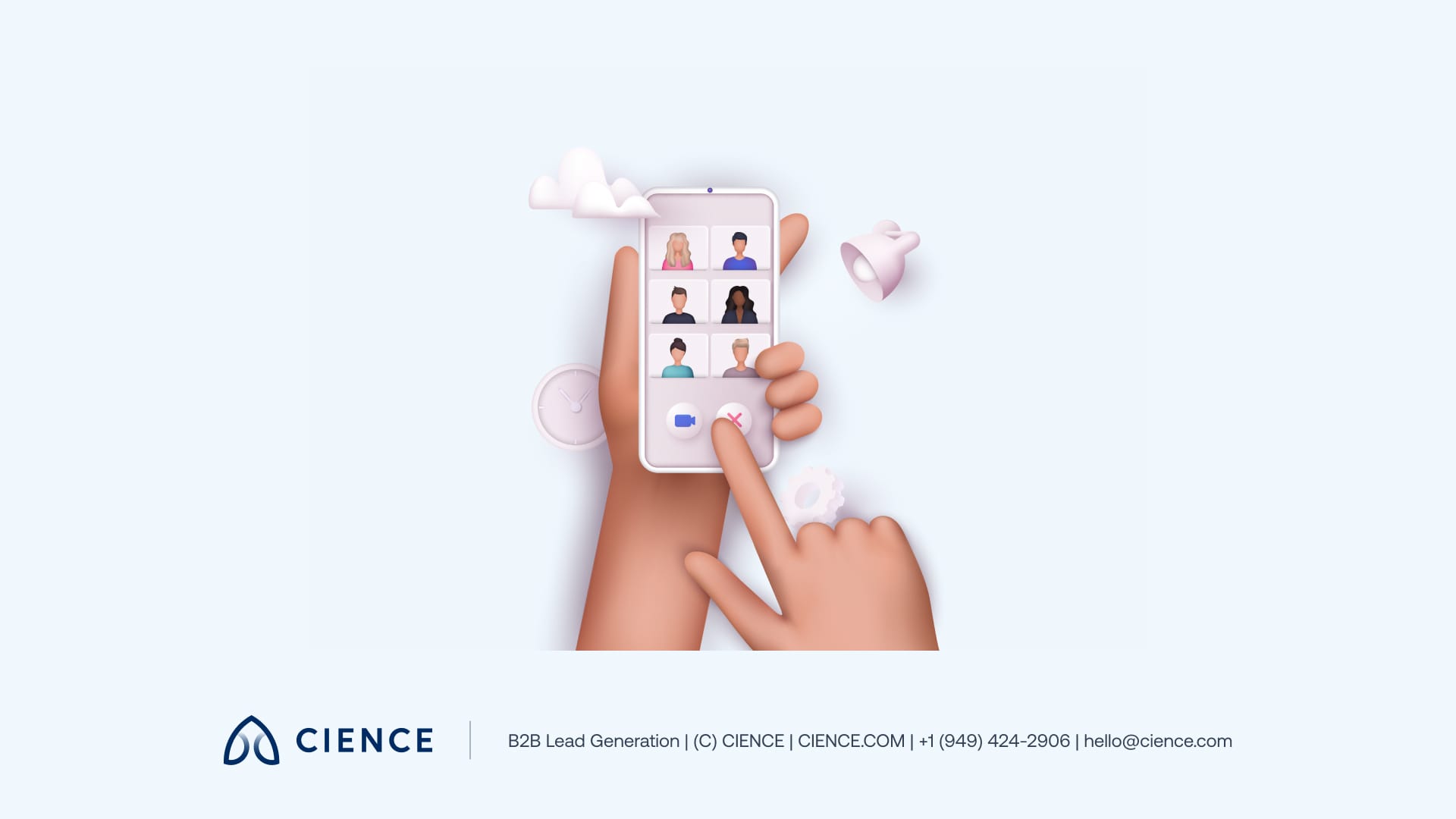
B2B Appointment Setting Over the Phone
Another way to schedule an appointment is through the phone, and in the lead generation saga, cold calling is responsible for that. Cold calling is a tricky subject: While some say it’s the best way to reach prospects, others consider it dead. We say it’s neither.
Cold calling is highly effective when combined with other types of outreach to warm it up (cold emailing, social media messaging, ads, etc.). Still, it also requires some persistence—most salespeople give up after a couple of attempts to reach a prospect over the phone.
How to set appointments via the phone
Use these four cold calling techniques to set up more appointments with prospects:
- Prepare. Professional researchers know how to find accurate and up-to-date information, including the correct telephone numbers. Be sure to find a direct line that connects right to the lead to avoid the gatekeeper.
- Warm-up. Before starting the outreach, it’s better to warm up your contacts. Cold calling is best paired with cold emailing, making a multichannel approach highly productive.
- Create a message. Before you pick up the phone, prepare what you are going to say. To achieve that, you must be fully aware of the value proposition, use personalization, and have a calling script in hand.
- Just call. The actual moment of asking for an appointment over the phone can seem terrifying. But don’t worry. you are most likely to succeed if you have a good lead, a message to warm it up, an appointment setting script, and some personalization in your bag of tricks.
B2B Appointment Setting Scripts
You never know what might happen during the appointment setting over the phone. The prospect might throw you off: their tone, manner of speaking, or the question. To ensure you won’t lose the ability to communicate, you should always have an appointment setting script by your side.
Appointment setting scripts are helpful in training SDRs, dealing with call reluctance, controlling the conversation, preparing for the next call, delivering the value proposition, and lifting the SDR’s confidence.
The best appointment setting scripts include:
- Introduction. The start of a conversation, including a proper greeting phrase, is significant to building rapport. A well-written script has a few options for conversation openers that state who you are and what company you represent. Since your cold call is not a monologue, we suggest taking pauses in your speech to give the prospect time to talk.
- FAQ (frequently asked questions). What do you do? Why are you better than your competitors? How much does it cost? A set of answers to these questions is the perfect glossary right on your desk.
- Prequalifying questions. Before setting an appointment, define whether you are looking at a qualified lead—someone who may actually go down your sales funnel. There are at least a dozen methodologies for that, but CIENCE prefers NOTE.
- Value proposition. It’s the key component of your sales pitch. You have to clearly show why your service can make a difference AND make your pitch client-centered. Make your message more about them and always bring value to the table.
- Appointment setting. If you’ve had a successful communication with a prospect, this is when you’ll want to negotiate the next steps. This can be either by following up (in case more information is needed) or scheduling an appointment.
Appointment setting scripts won’t do all the work for you; however, they will help connect you to the person on the other side of the line. Use your value proposition, personalization, and copywriter's content to engage the prospect.
💡 It’s also recommended to have a resource with common objections and ways to handle them.
Tip: Most importantly, listen and be human. And whenever you require some coaching, use cold calling scripts to help you through the pitch.
Best Time to Set Appointments
According to the sales specialization principle, the work of SDR is done once the appointment is scheduled, yet there is more you can do to minimize the risk of a no-show for your sales executives. Although there’s no universal time of the week that will work for all of your prospects, there are some time slots you can avoid.
According to Salesloft, the worst time to schedule a meeting is in the morning from 8 a.m. to 10 a.m. These three hours have the highest no-show rate. Conversely, the best time to set appointments is at the end of the day, from 3 p.m. to 5 p.m.
As for the days of the week, that same survey shows that Mondays and Wednesdays have the lowest no-show rates compared to Friday, which has the highest.
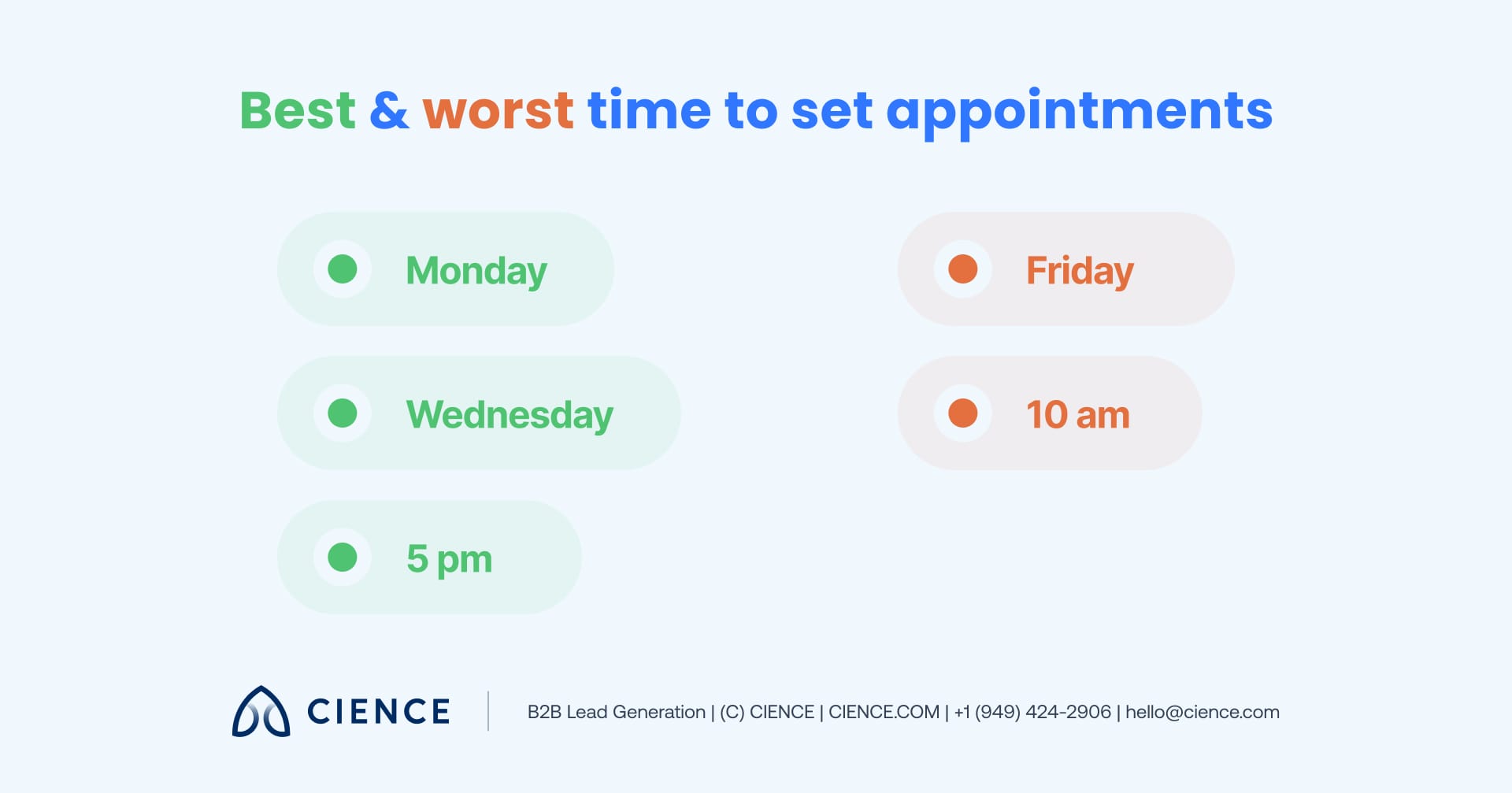
Avoid Monday mornings and Friday evenings in general; people are usually distracted by other plans during this time.
B2B Appointment Setting Pro Tips
Now that we’ve hit on the mechanisms of the appointment setting process, use these highly effective tips to achieve maximum results:
1. Always ask for an appointment.
Sounds silly, right? It’s what we're all thinking about—scheduling a meeting with a potential client. Yet, some SDRs may feel uncomfortable asking for an appointment, especially after an objection from the prospect. Our advice is to try to handle the objection and offer a non-obligatory meeting to get more information. Here's an example:
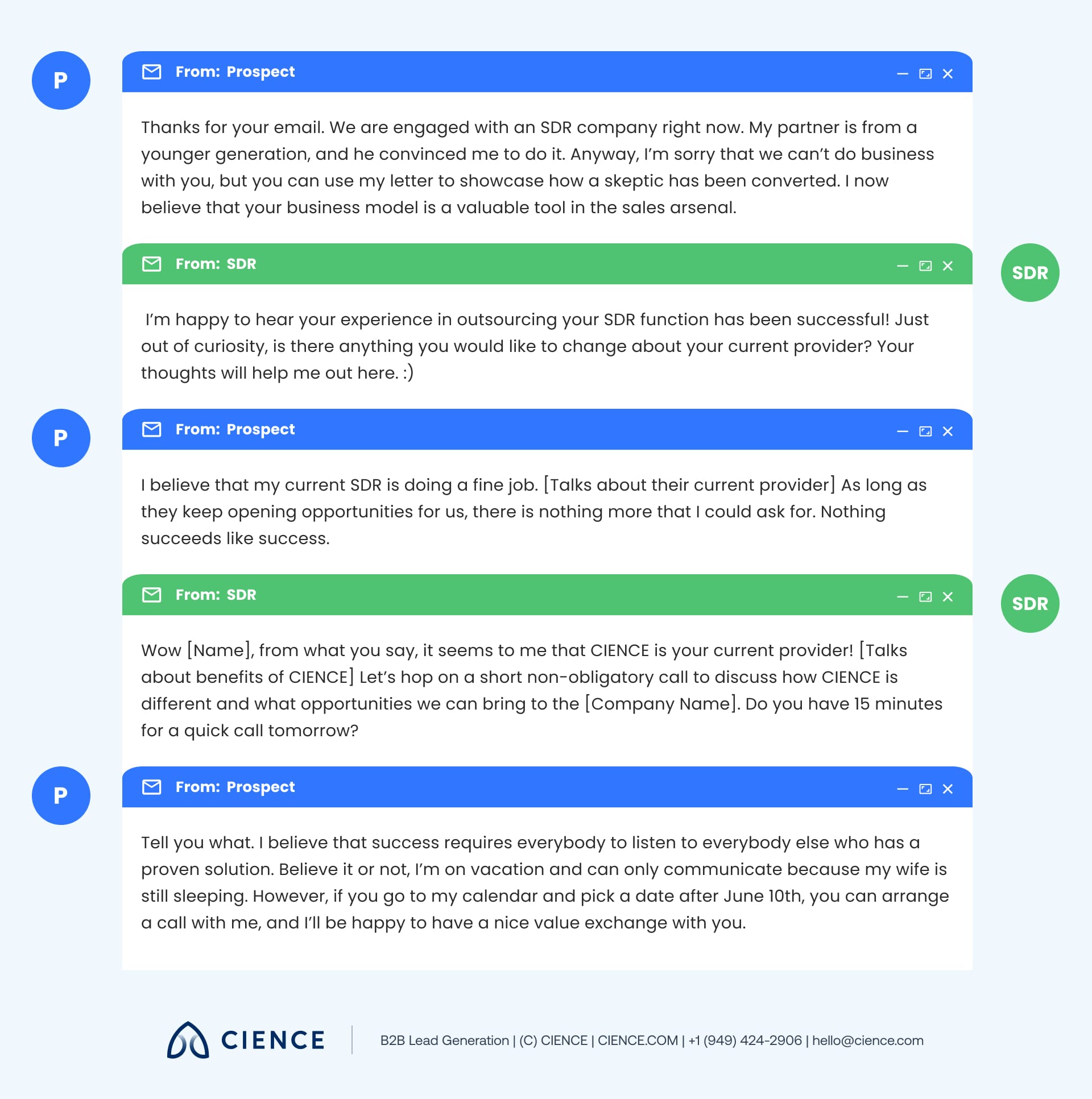
2. Know your audience.
Take time to study the ICP and BP to know the audience to target. For instance, the IT industry differs drastically from the tourism one. You have to know all the details to understand what kind of issues your potential clients face on a daily basis. Check out case studies to be knowledgeable about a certain industry.
3. Be human.
After the detailed research on the industry, our SDRs spend most of their time looking up info on every prospect: What is going on in their company? What challenges do they face? What victories have they celebrated?
This will be used to craft a personalized message that will speak directly to a decision-maker or decision-influencer. It will show prospects that they are talking to an actual human who took the time to get to know them.
4. Use your value.
We can’t say this enough. Know how to use your best weapon—the value that your company can bring to the table. That’s what hooks your clients. You can change your clients’ workflow for the best, and that’s a great argument you can make to set an appointment.
5. Use a multichannel strategy.
Multichannel outreach is one of the most effective lead generation strategies you can try in 2024. A social media touch warms up your cold email, while an email warms up a cold call. It increases the chances of a lead recognizing your brand and scheduling an appointment to find out more.
6. Choose the right time for the outreach.
Timing means a lot to the outreach. According to our sources, the best time to call a prospect is on Wednesday mornings; the best time to send an email is early in the morning (8:00 a.m.), with Wednesday also being the optimal day. However, we suggest testing various time slots and finding those that work for you.
7. Follow up and circle back.
According to the industry standard, an effective sales cadence includes eight touches. However, 7 out of 10 sales representatives don’t follow up with prospects after the first unanswered email. Be among those three people who do follow up to get more appointments.
Also, never forget to circle back to prospects when they seem interested but use the “it’s not the right time” objection. Here's how our SDR scored a victory:
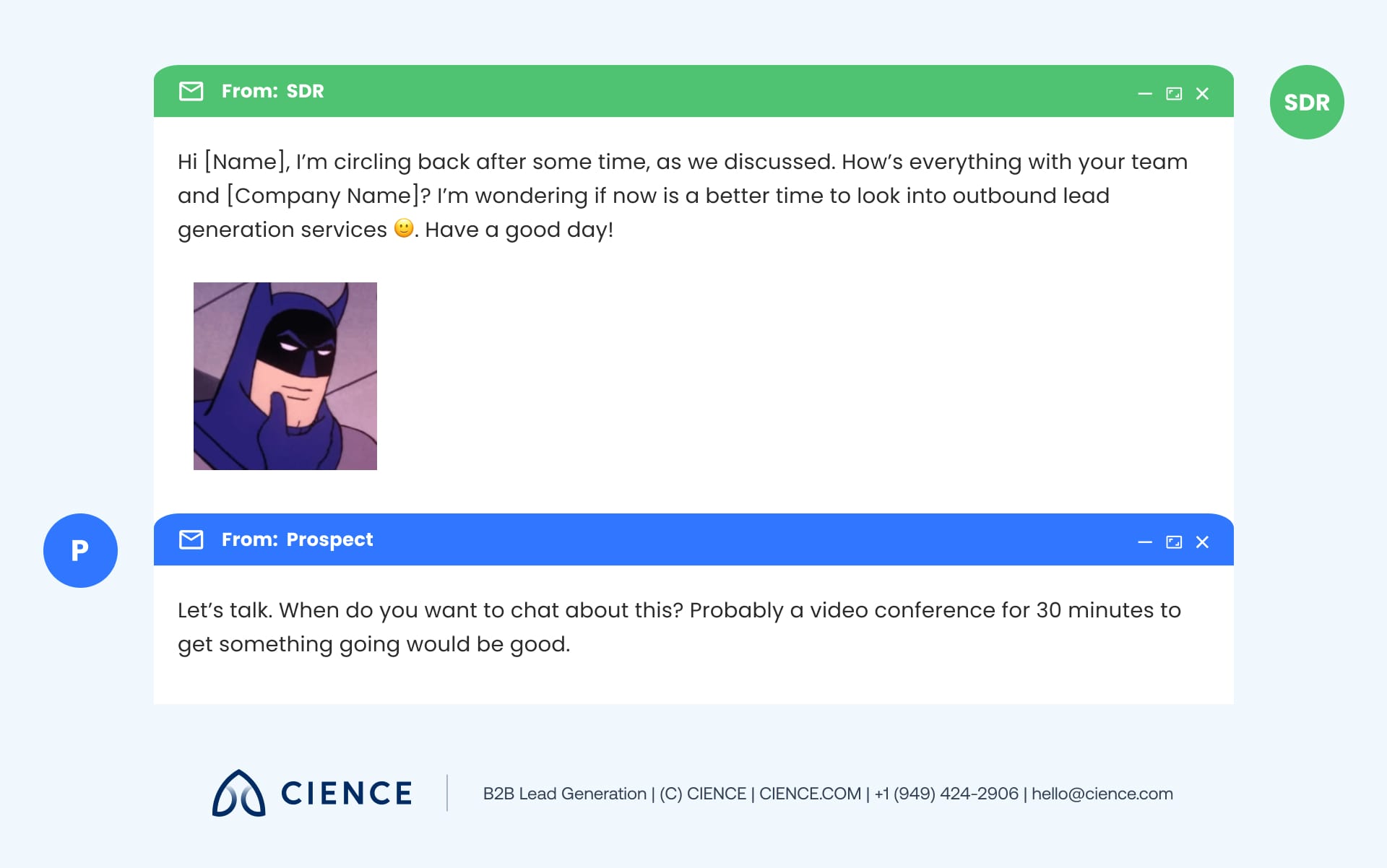
8. Use interactive content.
Using interactive content generates two times more conversions than other content does. It’s one of the trendiest SDR practices that is here to stay. It stands out from other sales prospecting emails and may send a more positive impression to the recipient. Get creative by using emojis, pictures, and even videos to boost your response rate like the example below:
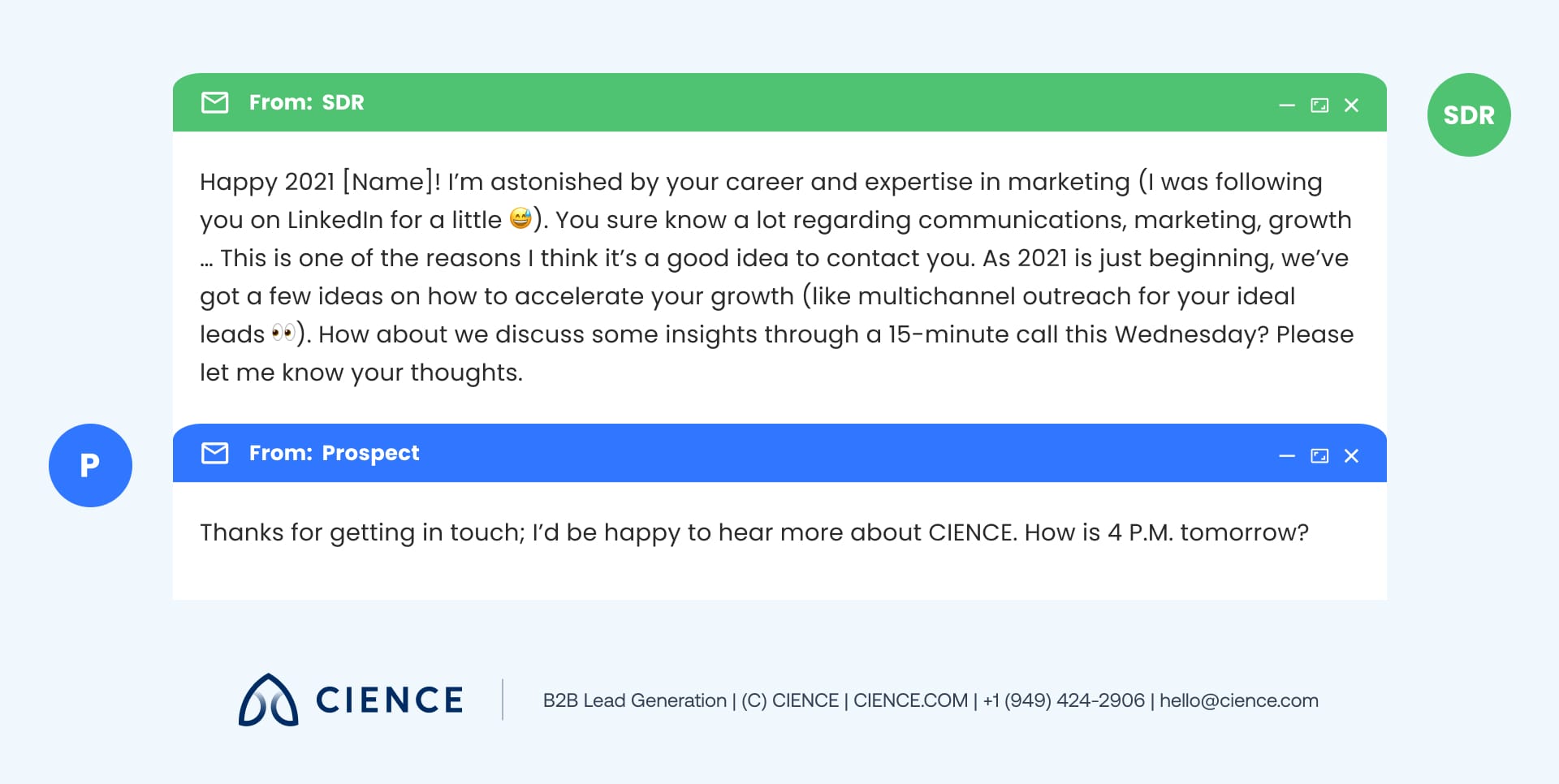
9. Use your humor.
Sometimes, it’s tricky being in sales. Besides reaching the stars, sales teams often have to face rejections. So it’s only reasonable to laugh about certain things and even use humor as part of your outreach. You may try using humorous subject lines, creative openers, memes, and GIFs like in the example below:
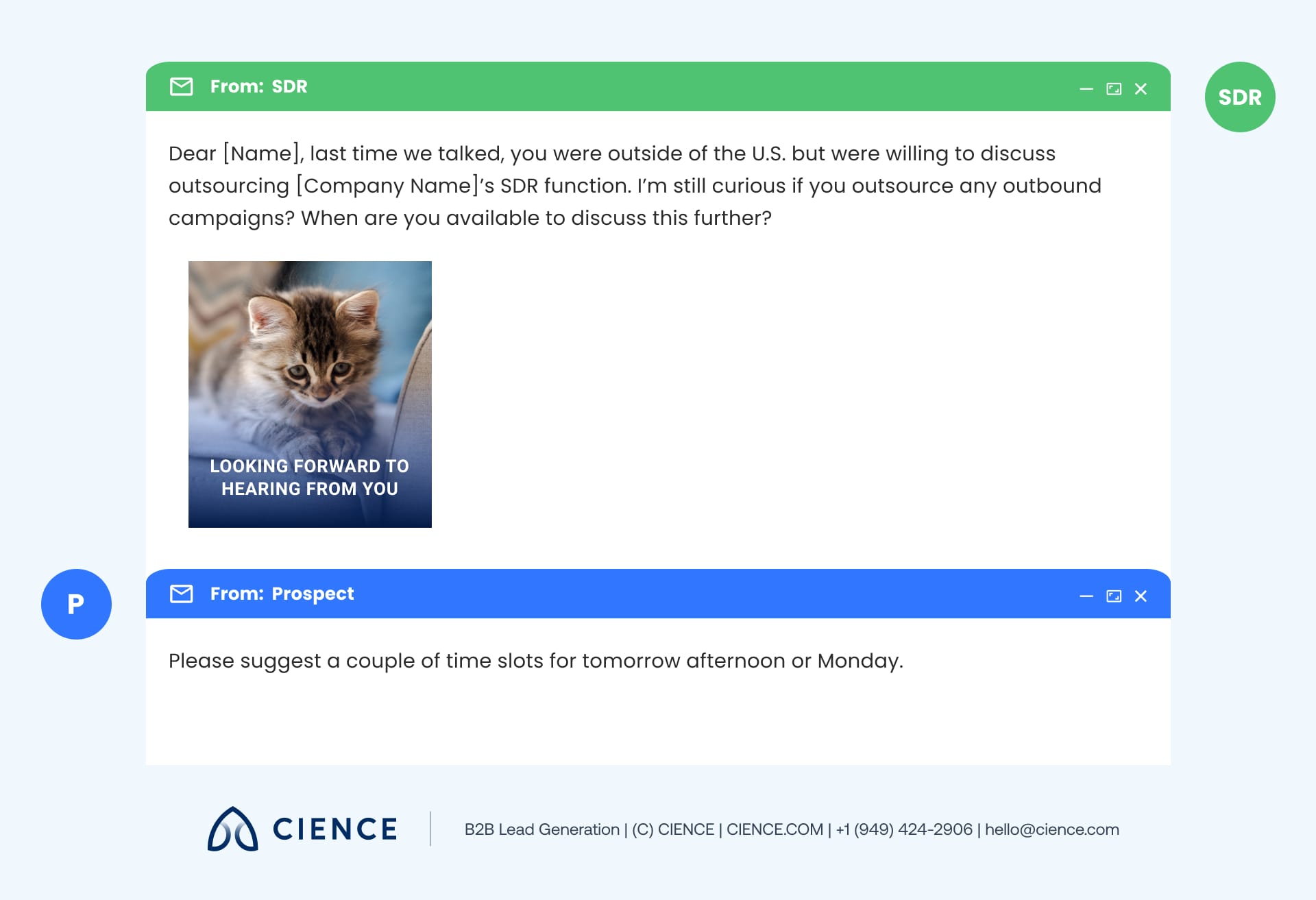
Should You Outsource Appointment Setting?
Outsourcing an appointment setting company has become a top choice for many B2B brands. They have found that it is possible to avoid the cost and effort of filling this role internally while also accepting that there are a lot of training expenses involved in perfecting B2B appointment setting.
Some of the costs that can be avoided through outsourcing appointment setters are:
- Recruiting for the high turnover of SEs and SDR positions
- Constantly educating and preparing new SEs and SDRs
- Licensing for lead appointment setting hardware and software
Before outsourcing to an appointment setting team, consider the achieved KPIs and other metrics in the recent past. If the results failed to meet your expectations, this might indicate that your company should focus on what it does best and leave the lead-pursuing to the pros.
Leverage B2B Appointment Setting to Boost Your Sales
Lead generation, lead qualification, lead research, targeting, and appointment setting are all among the sales specializations that take time to master.
Though we’ve discussed the many fine points of what B2B appointment setters do, how appointment setting works, ways to ask for appointments, and even shared the tricks that have made us successful, it's still not the same as doing it professionally for years.
CIENCE has positioned itself as one of the top B2B appointment setting providers in the industry. So, if you need some experienced pros to work on outbound strategies for your business, you know where to find us.
